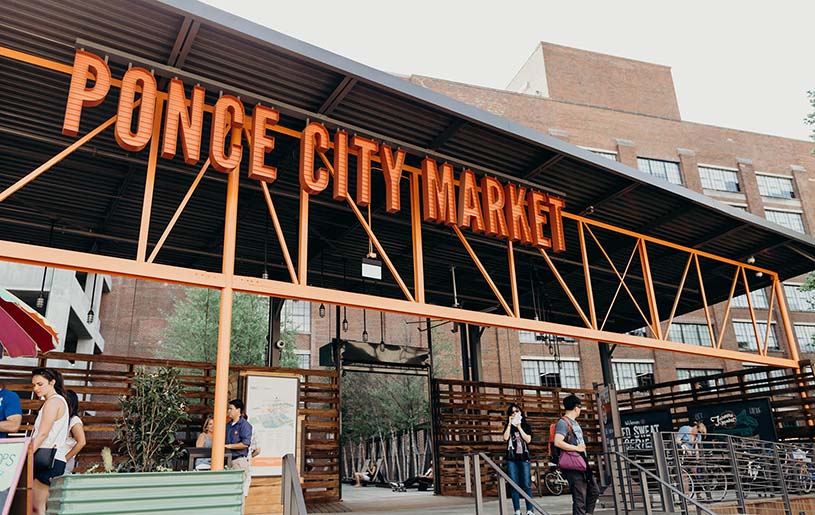On this journey of exploration, I have ventured into many renowned cities, witnessing countless breathtaking landscapes. However, one city that always captivates me is Atlanta. The heart of Georgia and a cultural hub of the American South, it holds many undiscovered treasures. It’s not just a bustling commercial center but a place where history and modernity intertwine, and nature coexists with humanity.
I want to take you through the city of Atlanta, revealing the charming scenes hidden behind the bustling metropolis. You will follow my footsteps, experiencing how Grant Park awakens in the morning light, listening to the stories told by the walls on Edgewood Avenue, and strolling through the Swan House’s garden, which seems to transport you back in time. We will also visit Oakland Cemetery to feel the weight of history and finally experience the perfect blend of modernity and nostalgia at Ponce City Market. These places may not appear on the front pages of travel guides, but it is these lesser-known spots that have made me truly appreciate Atlanta’s uniqueness and depth.
The Journey from Carlisle to Atlanta
I set out from Carlisle, Pennsylvania, a quiet town known for its rich historical and cultural atmosphere. However, as I decided to head to Atlanta, I knew it would be a journey spanning hundreds of miles, connecting a modern city with a historical town.
I chose to drive without hesitation. Road trips not only allow me to freely plan my route but also enable me to stop along the way to appreciate unplanned scenery or explore unexpected towns and attractions.
Starting from Carlisle, I took I-81, a highway that runs through Pennsylvania, Maryland, Virginia, Tennessee, and eventually into Georgia. Along the way, I traversed the rolling Appalachian Mountains, scaling towering peaks, and the majestic natural beauty made me eager for the journey.
Driving through the countryside of Virginia, the roadsides were lined with vast fields and pastures, with cows and sheep grazing amidst lush greenery. The tranquility and harmony of this land seemed like a time-frozen painting, each frame exquisitely beautiful. I decided to stop in a small town in Virginia for a moment, taste local cuisine, and chat with the locals to learn about their lives. Here, I discovered a hidden café nestled in the mountains, run by a storyteller of an elderly gentleman who shared the past and future of this land with me, enriching my journey with new insights.
After 10 hours of driving, I chose to spend a night in Knoxville, Tennessee. Knoxville is a vibrant city with both a rich history and a variety of cultural activities. I opted to stay at a boutique hotel in the city center, renowned for its unique Southern-style décor and warm service. At dinner, I enjoyed the local specialty BBQ—slow-cooked pork with homemade barbecue sauce, rich in flavor and texture. Each dish seemed to narrate the city’s past, filled with a touch of smokiness and a strong sense of community.
The next morning, I continued south, heading towards Atlanta along I-75. Upon entering Georgia, the roads widened, and the trees grew taller and denser. As I drove into Atlanta, the city’s skyline became increasingly visible in the distance, and at that moment, a wave of excitement and anticipation surged through me. I knew that this city awaited my exploration.
By Plane — The Convenient Option
If you are pressed for time or prefer not to drive long distances, flying is undoubtedly a quick and convenient choice. From Carlisle’s nearest airport—Harrisburg International Airport—it takes only about 2 hours and 30 minutes to reach Hartsfield-Jackson Atlanta International Airport. This airport is not only one of the busiest in the world but also a modern transportation hub with various convenient ground transport options.
Upon arriving at Atlanta Airport, you can choose to rent a car, take a taxi, or use the MARTA subway system to reach downtown. MARTA is Atlanta’s primary public transportation system, with both the red and gold lines leading to downtown, which saves time and helps you quickly adapt to the city’s pace.
Atlanta is known for its rich history, bustling commercial areas, and diverse cuisine. However, beyond its famous tourist attractions, the city also hides many lesser-known treasures. These spots quietly stand in the city’s corners, waiting for those who are keen to discover them.
Grant Park

Grant Park is one of Atlanta’s oldest and most beautiful urban parks. As you enter, it feels like stepping into a secluded oasis, away from the city’s hustle and bustle, with only the tranquility of nature and pure air accompanying you.
In the morning, I visit Grant Park, where the mist has yet to lift, and the morning light filters through the treetops onto the grass. The air is filled with the fresh scent of greenery. I enjoy walking here, with the small gravel paths making a gentle crunching sound underfoot, surrounded by lush trees and occasional bird songs. The park features expansive lawns, perfect for picnics or spending a peaceful afternoon with friends and family.
On the west side of the park is a serene lake, its surface like a mirror, reflecting the blue sky and white clouds. There is a small dock by the lake where you can rent a rowboat and gently row to the center of the lake to savor the tranquility. I once rented a rowboat on an afternoon, and as the boat rocked gently on the water, my thoughts seemed to float along the calm surface, leaving me feeling exceptionally relaxed.
Grant Park also houses the Atlanta Zoo, which is a great place for families. The zoo features a wide variety of animals, from majestic lions to charming pandas, all living in carefully designed habitats. I particularly enjoy the panda exhibit, one of the few places in the world where you can see giant pandas. Watching these fluffy “national treasures” lazily munching on bamboo fills me with warmth and joy.
After leaving the zoo, I wandered along the south side of the park, where there is a Victorian-style residential area preserving 19th-century architecture. These colorful old houses seem to tell the story of Atlanta’s former glory and history. Each house has a unique design, with gardens full of flowers. As you pass by, you can almost feel time standing still at that moment.
Edgewood Avenue
After leaving Grant Park, I headed to Edgewood Avenue, which is not far from downtown. This street is a hub for Atlanta’s street art and culture, offering a strong visual impact and cultural atmosphere.
The walls of Edgewood Avenue are covered with various graffiti artworks that are not only colorful but also deeply thoughtful and socially aware. Each piece of graffiti is an artist’s expression of social phenomena, personal experiences, or emotions. The street art here is not just mere graffiti but is integrated with Atlanta’s historical and cultural context, becoming an important symbol of the city.
I particularly like a massive mural here that depicts the silhouette of Atlanta’s city skyline against a fiery sunset. The whole scene is filled with power and vitality. Standing in front of this mural, I couldn’t help but marvel at the power of art—it’s not just a visual pleasure but also a spiritual impact.
On Edgewood Avenue, you can also find many small art galleries and independent bookstores. These places, though unassuming, are full of surprises. I walked into a gallery where the walls were adorned with works by local artists, each with a unique style but all exuding sincerity and enthusiasm. I bought a small painting as a souvenir of this trip.
In addition to art, there are many small bars and coffee shops, each with its own unique style and atmosphere. I chose a nostalgic café, ordered a cup of hand-brewed coffee, and sat by the window, watching the bustling street and the flow of people outside. I could feel the city’s unique rhythm while enjoying the rich and aromatic coffee, with each sip revealing the complex layers and delicate flavors of the coffee beans.
The Swan House
If you’re interested in historical architecture and gardens, The Swan House is a must-visit. Built in 1928, this mansion was once the residence of wealthy businessman Edward Inman and his family. It is now part of the Atlanta History Center.
The Swan House is a quintessential example of Georgian-style architecture, with its white exterior, symmetrical design, and intricately carved porch exuding elegance and nobility. Walking into this mansion feels like stepping back into the 1920s, an era of luxury and romance.
I was struck by the interior decoration of this grand house—high ceilings, exquisite chandeliers, classical furniture, and artwork on the walls—all showcasing the opulence of that era. Our guide led us through each room, from the lavish living room to the cozy bedrooms, each corner filled with a sense of history. In the master bedroom, I saw an old four-poster bed with draped curtains, as if still holding the presence of its former occupants.
The gardens of The Swan House are equally breathtaking. The horticultural design blends European classical styles with Southern plant varieties, featuring fountains, sculptures, and stone paths that make you feel as though you’re in an European aristocrat’s estate. I wandered through the garden, enjoying the dappled sunlight filtering through the leaves, accompanied by the soothing sounds of flowing water and birdsong.
There is also a small museum at The Swan House that displays the history of the Inman family and their contributions to the development of Atlanta. Here, I learned much about the social changes and economic development of Atlanta in the early 20th century, experiencing the city’s transformation from a small town to a modern metropolis.
Oakland Cemetery
Oakland Cemetery is Atlanta’s oldest cemetery and a place that is both solemn and full of stories. It is not only a resting place but also a microcosm of Atlanta’s history and culture.
Many notable historical figures are buried here, including soldiers from the Civil War, politicians, and social elites. Walking along the paths of the cemetery, surrounded by towering oak trees and evergreen pines, there is a solemn and respectful atmosphere. I felt a sense of dialogue with history, as if each gravestone was telling a long-forgotten story.
One of the most notable sites is a large mausoleum belonging to Margaret Mitchell, the author of Gone with the Wind. Standing before her grave, I couldn’t help but reflect on the plot and characters of that classic novel, as if the turbulent times of the story were unfolding once again.
In addition to the graves of famous individuals, the cemetery’s garden design is also worth noting. The flower beds, sculptures, and old stone markers create picturesque scenes, almost like an open-air museum. Every aspect of the cemetery is meticulously designed and maintained, offering both a sense of history and a feeling of tranquility and peace.
At the center of the cemetery, there is a small museum showcasing the history of the cemetery and the development of Atlanta. Through these exhibits, I gained a deeper understanding of the city’s history and the unique value of this cemetery.
Ponce City Market

After leaving Oakland Cemetery, I headed to Ponce City Market, a perfect blend of modernity and history in Atlanta. Located in the Old Fourth Ward, this area, once an industrial zone, has now become one of Atlanta’s most vibrant commercial and cultural centers.
Ponce City Market was originally the Sears Building, constructed in 1926, which served as a distribution center for Sears, one of America’s largest retail companies. Today, this historic building has been transformed into a multifunctional space encompassing shopping, dining, offices, and residences.
Upon entering Ponce City Market, I was immediately attracted to its unique industrial style. Red brick walls, steel structures, and large windows give the building a sense of history, while the modern interior design brings it new life. The market features a variety of stores and restaurants, from boutique apparel to handcrafted goods, and from upscale dining to street food, catering to all your shopping and culinary needs.
I spent quite a bit of time in the market’s food hall, sampling various authentic Southern dishes. Each restaurant has its own character, but I particularly enjoyed a place specializing in Southern cuisine. Their fried chicken and biscuits are exceptional. The chicken is crispy and golden on the outside, juicy and tender on the inside, paired with homemade sauce that makes each bite unforgettable. The freshly baked biscuits, crisp on the outside and soft on the inside, filled with buttery flavor and a touch of honey, truly represent Southern flavors.
Ponce City Market is not just a paradise for shopping and food but also a cultural and artistic gathering spot. On the top floor of the market is an open rooftop park called “The Roof.” It features a mini-golf course, game area, bar, and observation deck. From here, you can take in the entire Atlanta skyline. I especially enjoy coming here in the evening, sipping a cocktail while enjoying the breeze and music, and taking in the beautiful night view of Atlanta. The experience is simply indescribable.
Alfred Blalock Avenue
Alfred Blalock Avenue is a hidden gem in Atlanta, a street not very long but full of artistic flair and historical depth. Located near downtown, it is a district that has been gradually transformed by artists, now representing independent art and culture in Atlanta.
The street is renowned for its diverse murals and street art, with every wall and corner brimming with creativity and imagination. Here, each artwork seems to tell a story, reflecting social changes, cultural fusion, and personal expression. My favorite is a vibrant and dynamic mural depicting a group of children running through the street, capturing a sense of vitality and freedom that evokes the passion and beauty of life.
Alfred Blalock Avenue also features several small art galleries showcasing local artists’ work. Each gallery has its own style, ranging from abstract paintings to realistic works, with each piece full of creativity and emotion. I discovered a particularly special painting in one gallery, depicting an old bridge with water flowing calmly beneath it, creating a sense of tranquility and harmony. I was immediately drawn to it and decided to purchase it as a memento of my visit to Atlanta.
In addition to art, the street is home to several distinctive cafes and bars, each with its own unique decor and atmosphere. I settled in a small café, ordered a latte, and enjoyed the bustle of the street while immersing myself in my thoughts. The coffee here is rich and aromatic, with each sip offering a taste of the coffee beans’ unique flavor, like a soothing balm for the soul.
Alfred Blalock Avenue is not just an artistic haven but also a social and cultural hub. The area frequently hosts various small concerts, art exhibitions, and street parties, attracting many young people and art enthusiasts. I had the fortune of encountering an impromptu street performance here, where music and art blended perfectly, allowing me to experience Atlanta’s diversity and inclusiveness.
Atlanta is not only a gem of the American South but also a city rich in history, culture, and modern vitality. By exploring these lesser-known spots in the city, I deeply felt the unique charm of Atlanta. Whether it’s the morning serenity of Grant Park, the artistic ambiance of Edgewood Avenue, the historic grandeur of The Swan House, or the solemnity of Oakland Cemetery, each place provided me with a deeper understanding and emotional connection to Atlanta.
Travel is not just about sightseeing but also about experiencing a way of life, exploring different cultures and histories. With its diverse culture, rich history, and modern vibrancy, Atlanta has become an unforgettable stop in my travel journey. I believe this city holds many more undiscovered treasures waiting for us to find and experience. Whether it’s the freedom of driving across state lines or the surprises found in city corners, this journey will become one of your most cherished memories.


